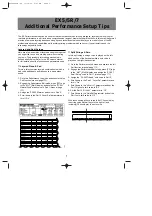
17
mer am eigenen, gleichen Platz, usw. Alle GM Geräte
(sowohl Hardware als auch Software Sound Module) sind
als solche klar gekennzeichnet. Wenn also ein GM Gerät
MIDI- Program Change Befehle erhält, so werden Sounds
aufgerufen, die man auf Grund des GM Geräte Sound-
Set erwarten würde. Alle nicht-GM Geräte rufen Sounds
durch ihren Speicher auf nachdem MIDI-Program Change
Befehle empfangen wurden. Da in nicht-GM Geräten die
Sounds nicht in einer bestimmten Art geordnet sind, ist
es nötig das Gerät zu prüfen, um zu erkennen, welcher
Sound gewünscht wird und an welcher Stelle dieser ge-
speichert ist.
Bank Change Befehle sind sinnvoll, wenn man Sounds aus
einer großen Library aufruft, die möglicherweise in einem
bestimmten Soundmodul oder Software Synthesizer exis-
tiert.
6. Problembehebung
Die Kontrolux Keyboards wurden entwickelt, um Ihnen
die best mögliche MIDI-Kontrolle zu bieten. Dennoch gibt
es praktisch unendlich viele Anwendermöglichkeiten; jede
dieser Möglichkeiten könnte die Performance Ihres Sys-
tems beeinflussen. Obwohl dieser Abschnitt nicht alle
möglichen Situationen wiederspiegeln kann, finden Sie fol-
gend einige Vorschläge zur Problembehebung.
Wenn Sie Ihr Kontrolux Keyboard mit einem Computer
verbinden, wird empfohlen, nicht allzu viele Geräte gleich-
zeitig an Ihren Rechner anzuschließen. Je mehr Geräte
angeschlossen werden, desto größer ist die Belastung
des CPU. Obwohl es theoretisch möglich ist, mehrere
USB-Geräte gleichzeitig anzuschließen, könnte dies die
Performance Ihres Computers nachteilig beeinflussen.
Problem:
Mein Kontrolux hat nach der Installation mit einem Com-
puter problemlos funktioniert und auf einmal ist es ohne
Funktion.
Mögliche Lösung:
Schalten Sie das Keyboard und Ihren Computer aus und
schalten Sie beides erst nach ca. 10 Sekunden wieder
ein. Starten Sie den Rechner erneut und schalten Sie Ihr
Kontrolux Keyboard ein. Falls das Problem weiterhin auf-
taucht, müssen eventuell die Treiber neu installiert wer-
den.
Problem:
Es wurde ein Sustain Pedal an das Keyboard angeschlos-
sen, aber es fuktioniert nur in entgegengestzter Richtung.
Mögliche Lösung:
Die Polarität des Sustain Pedals wird vom Kontrolux Key-
board berechnet, sobald Sie es einschalten. Beim Ein-
schalten wird davon ausgegangen, dass sich Ihr Pedal
in der Off-Position befindet. Möchten Sie also, dass das
Pedal aus ist, wenn es nicht gedrückt wurde, stellen Sie
sicher, dass das Pedal beim Einschalten nicht gedrückt
wird. Um die Polarität umzukehren, drücken Sie das Pedal
und halten Sie es gedrückt, während Sie das Keyboard
einschalten.
hINWEIS:
Dies muss bei jedem erneuten Einschalten vorgenommen
werden.
Problem:
Das Kontrolux Keyboard ist mit dem Computer verbun-
den. Wenn ich eine Keyboard- Taste drücke gibt es eine
Verzögerung, bevor man etwas hören kann.
Mögliche Lösung:
Diese Verzögerung ist auch unter dem Begriff Latenz be-
kannt. Latenz bei MIDI-Signalen entstehen am Computer
und nicht an Ihrem Kontrolux Keyboard. Dies kann an
clear that their sounds are organized in the General MIDI
structure. So when a GM device receives a MIDI Program
Change, it calls up a type of sound that one would expect
from the GM sound set. All non-GM devices call up unique
sounds from their memory upon receiving MIDI Program
Changes. Since the sounds in a non-GM device are not
arranged in a particular order, one needs to take a look
at the device itself to see which sound is desired and at
which location in the memory it resides.
Bank change messages are useful when calling up sounds
from a large library that may exist in a particular sound
module or software synth.
6. Troubleshooting
The Kontrolux series has been designed to offer high per-
formance MIDI control. However, there are virtually limit-
less numbers of operating scenarios, any of which could
affect your system‘s performance. Although this section
cannot cover all possible situations you may encounter,
we would like to offer some suggestions for dealing with
common problems.
If you are connecting to a computer, we recommend that
you avoid connecting too many devices to your computer
at the same time. The more devices you have connected
to the computer, the greater the load on the computer‘s
CPU. Although it is possible in theory to connect multiple
USB devies at the same time, doing so may degrade your
system‘s performance.
Problem:
My Kontrolux suddenly stopped working after having per-
formed well since the installation on a computer.
Possible remedy:
Switch off the unit and leave it off for 10 seconds. Then
restart your computer, power up your Kontrolux and try
again. If the problem persists, you may have to reinstall
the drivers for the unit.
Problem:
I have plugged in a sustain pedal to my Kontrolux, but it
works backwards.
Possible remedy:
The polarity of the sustain pedal is calculated by the Kon-
trolux when it is powered up. On power up, the sustain
pedal is assumed to be in the off position. So, if you want
the sustain pedal to be off when it is not depressed, make
sure not to press the pedal when you power up. To rever-
se the pedal polarity, just press and hold the pedal while
powering up.
NOTE!
This will have to be done each time you power up the
Kontrolux.
Problem:
I have connected the Kontrolux to my computer. When I
press a key, there is a delay before I hear any sound.
Possible remedy:
This delay is known as latency. Latency with MIDI signals
is caused at the computer and is not coming from the
Kontrolux. This may be due to the CPU load of the soft-



































